Somehow I never saw this thread promoted with a new message, although I usually check on my phone which makes it easy to miss. I still wouldn't have had an answer though
Anyway, hope someone gains some insight from all of this. Back to making sawdust...
I did. Interesting that the midrange seemed to be more affected by the facets than the tweeter. I wonder if the fact that the tweeter is in a LITTLE bit of a waveguide, maybe it didn't "see" the facets as much.
I was going to respond, but I couldn't understand the graph patterns. I was afraid I might stick my foot in my mouth, so I kept it shut. I kept looking at the first midrange polar set that you posted and was wondering why the curves were offset so much below 1kHz. Now, after looking more closely, I can see why. The scale is only 2dB per division (when I initially looked I thought it was 5dB/division). I agree with your assessment that the power response will probably be hot in the 2-3kHz region due to the combination of polar response bunching and the overall driver directivity mismatch. The question is, how much of a problem will this really be? And will you be able to correct it significantly using various crossover design tricks?
PS: I suppose you could look at it this way: The baffle shape introduces a certain amount of power response peaking & dipping based on it's overall shape and dimensions. The individual drivers start to beam at different frequencies, which, in turn, introduces another set of frequency dependent power response peaks and dips. The problem is that I am still trying to figure out how to properly select the right drivers and build the right cabinet shape to cause all these curves to self-correct each other.
@rjj45 said:
re: @4thtry - me too! Seems like we have to build boxes and measure, and only then do we find a problem.
That's pretty much what I've always done. I guess we could spend the time to learn all the fancy modeling programs and all end up with the same speaker? 😛
As for a crossover, looks like 2K is what the mid kinda wants (directivity wise), but I don't think the tweeter is gonna like that. I next need to run some distortion measurements.
I liked the copper trim CSS used on their big speaker build. I also liked the flashing sealant they used to adhere the baffles to the boxes. I bought some 1/16"x1/2" copper strips and inlayed them into the backside of the baffle. Then once fitted to the enclosures, it'll all be flush trimmed.
Little more done today. Cut the top and bottom angles on the baffles and trimmed the sides up to be able to easily flush them to the enclosure.
I think maybe driver openings are next....then decide how I'm going to do the facets.
Decided to flush trim the baffles so I could layout the drivers properly. I used the brad nail trick to keep the baffles from sliding around. If you don't know what that is, you hammer a few brad nails in, leaving about a 1/4" proud. Then take some side cutters and nip the protruding piece off. This leaves a sharp pointy bit that'll stick into the piece of wood laying on top. Once the baffle was were I wanted it, ya just pound down on it and the little pointy bits keep it from moving.
Then I just clamped the baffle to the enclosure on the opposite side of where I was flush cutting. Rotate and repeat. Done and still removable. Then it was easy enough to make the proper measurements to align the drivers with where they'll reside.
Definitely driver rebates and holes up next.
...crazy how much the right baffles walnut aged/oxidized compared to the left one from just sitting on top of it for the last year!
I would use a router with a straight bit mounted to a block with the bit at block depth. You could also clamp the block/board, and freehand the router.
Mids on Thursday, woofers on Friday, and tweeters today. Another piece of the puzzle complete. I think addressing the bases is next. I've decided to do a base instead of the legs I was previously planning.
Started getting the solid stock walnut milled flat. Got a few hours in before the rain came.... again.🤦🏻♂️ Anyway, got the boards roughed in, just need to pick two and make them the same thickness. This spoilboard surfacing bit rocks!! https://ebay.us/m/Y3E86U
Made a hell of a mess, sending walnut dust everywhere, including stuck all over me because of the wonderful weather we have. I swear the humidity had to have been 95%!!
Here's a few shots of the routing jig I set up to flatten the boards.
Those are CNC surfacing / flattening bits. They have replaceable blade inserts (the screw removed them) and you can turn the square blade 90 degrees and get 4 times the usage out of one cutter! Nice jig! Something about making your own jigs and using them is really rewarding. I’ve been wanting to do a miter spline jig for a long time.
As @D1PP1N stated, you get 4 cutting surfaces to use as the bit wears. First time I tried one and have to say I'm a big fan of it. It leaves a decent finish that's easily sanded smooth.
Got the bases cut out. They have ~5 degree bevel on all four sides, basically mimicking the baffle angle.
I wanted to put the crossover in the base, but depends on the inductors that end up being used. We'll see.
Comments
Somehow I never saw this thread promoted with a new message, although I usually check on my phone which makes it easy to miss. I still wouldn't have had an answer though
I did. Interesting that the midrange seemed to be more affected by the facets than the tweeter. I wonder if the fact that the tweeter is in a LITTLE bit of a waveguide, maybe it didn't "see" the facets as much.
I was going to respond, but I couldn't understand the graph patterns. I was afraid I might stick my foot in my mouth, so I kept it shut. I kept looking at the first midrange polar set that you posted and was wondering why the curves were offset so much below 1kHz. Now, after looking more closely, I can see why. The scale is only 2dB per division (when I initially looked I thought it was 5dB/division). I agree with your assessment that the power response will probably be hot in the 2-3kHz region due to the combination of polar response bunching and the overall driver directivity mismatch. The question is, how much of a problem will this really be? And will you be able to correct it significantly using various crossover design tricks?
PS: I suppose you could look at it this way: The baffle shape introduces a certain amount of power response peaking & dipping based on it's overall shape and dimensions. The individual drivers start to beam at different frequencies, which, in turn, introduces another set of frequency dependent power response peaks and dips. The problem is that I am still trying to figure out how to properly select the right drivers and build the right cabinet shape to cause all these curves to self-correct each other.
re: @4thtry - me too! Seems like we have to build boxes and measure, and only then do we find a problem.
That's pretty much what I've always done. I guess we could spend the time to learn all the fancy modeling programs and all end up with the same speaker? 😛
As for a crossover, looks like 2K is what the mid kinda wants (directivity wise), but I don't think the tweeter is gonna like that. I next need to run some distortion measurements.
I liked the copper trim CSS used on their big speaker build. I also liked the flashing sealant they used to adhere the baffles to the boxes. I bought some 1/16"x1/2" copper strips and inlayed them into the backside of the baffle. Then once fitted to the enclosures, it'll all be flush trimmed.
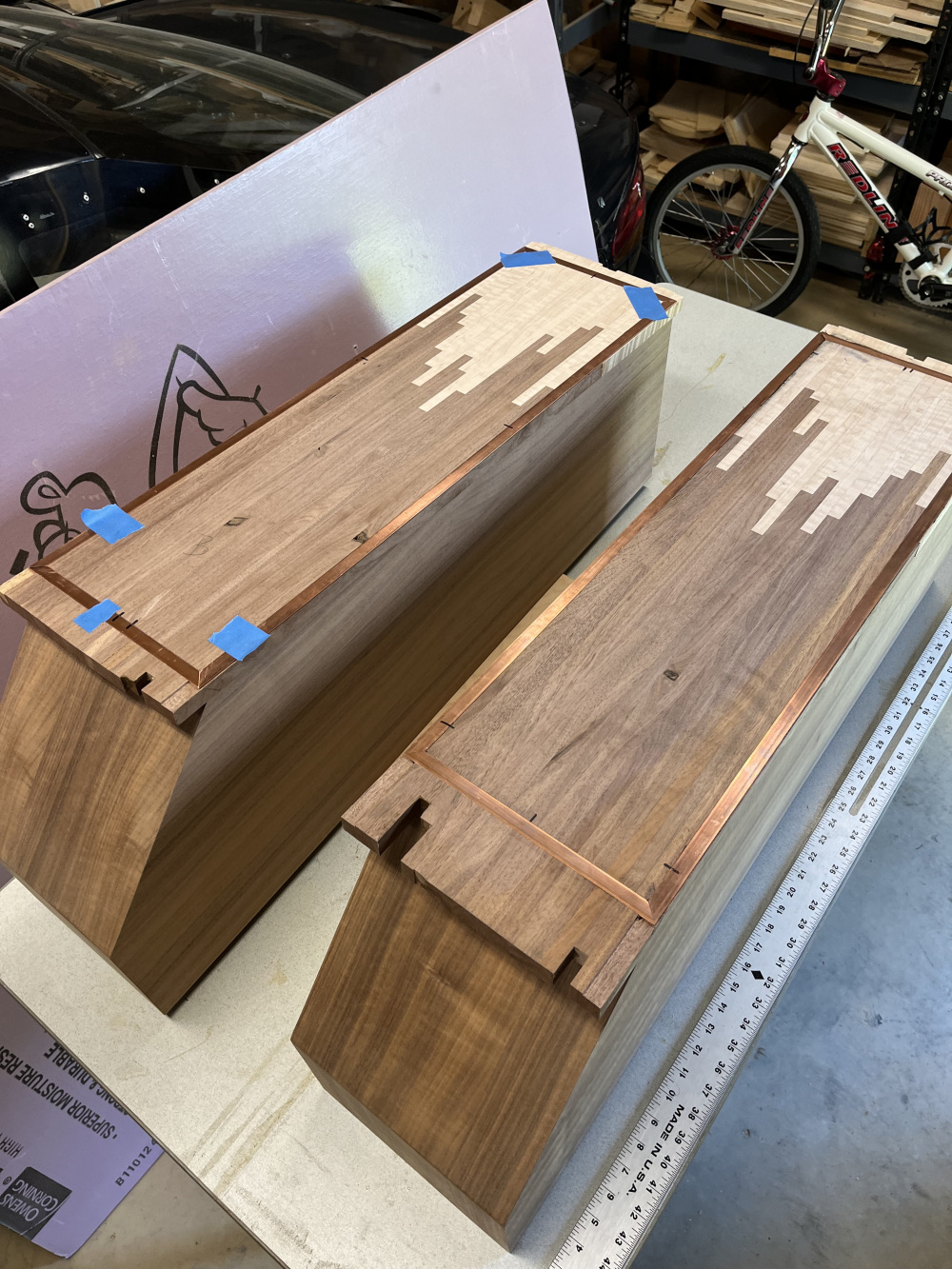
I also do whatever she lets me do
Redline making bikes again?
Honestly don't know, mines going on 30yrs old. Still an awesome ride👍🏻
It has the 7075 aluminum frame and rims, plus chromoly three piece crank.
Diamondback and Redline are owned by Regent LP. I don't think their BMX line has been intact continuously since the '80's, but it's there now.
Little more done today. Cut the top and bottom angles on the baffles and trimmed the sides up to be able to easily flush them to the enclosure.
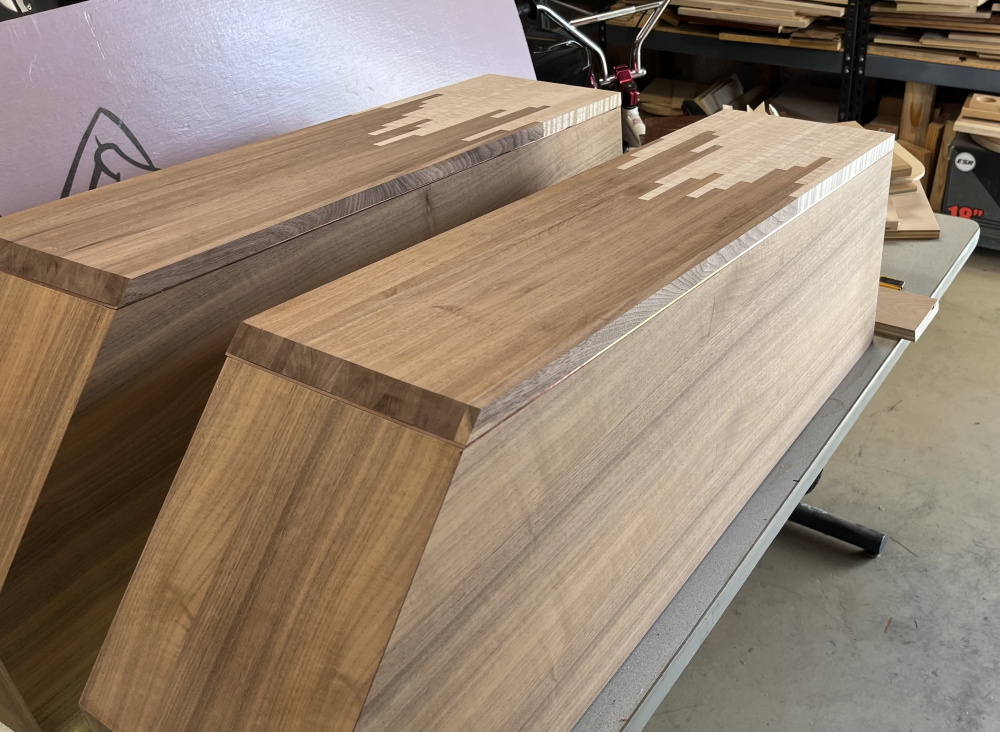
I think maybe driver openings are next....then decide how I'm going to do the facets.
Looks really nice. You guys that cut driver openings after the fact have balls… but then I look at your quality of workmanship
Decided to flush trim the baffles so I could layout the drivers properly. I used the brad nail trick to keep the baffles from sliding around. If you don't know what that is, you hammer a few brad nails in, leaving about a 1/4" proud. Then take some side cutters and nip the protruding piece off. This leaves a sharp pointy bit that'll stick into the piece of wood laying on top. Once the baffle was were I wanted it, ya just pound down on it and the little pointy bits keep it from moving.
Then I just clamped the baffle to the enclosure on the opposite side of where I was flush cutting. Rotate and repeat. Done and still removable. Then it was easy enough to make the proper measurements to align the drivers with where they'll reside.
Definitely driver rebates and holes up next.
...crazy how much the right baffles walnut aged/oxidized compared to the left one from just sitting on top of it for the last year!
Scotch pad should take that patina right off.
But how do you flush trim the non 90deg angle?
I would use a router with a straight bit mounted to a block with the bit at block depth. You could also clamp the block/board, and freehand the router.
InDIYana Event Website
With a table saw.
Mids on Thursday, woofers on Friday, and tweeters today. Another piece of the puzzle complete. I think addressing the bases is next. I've decided to do a base instead of the legs I was previously planning.
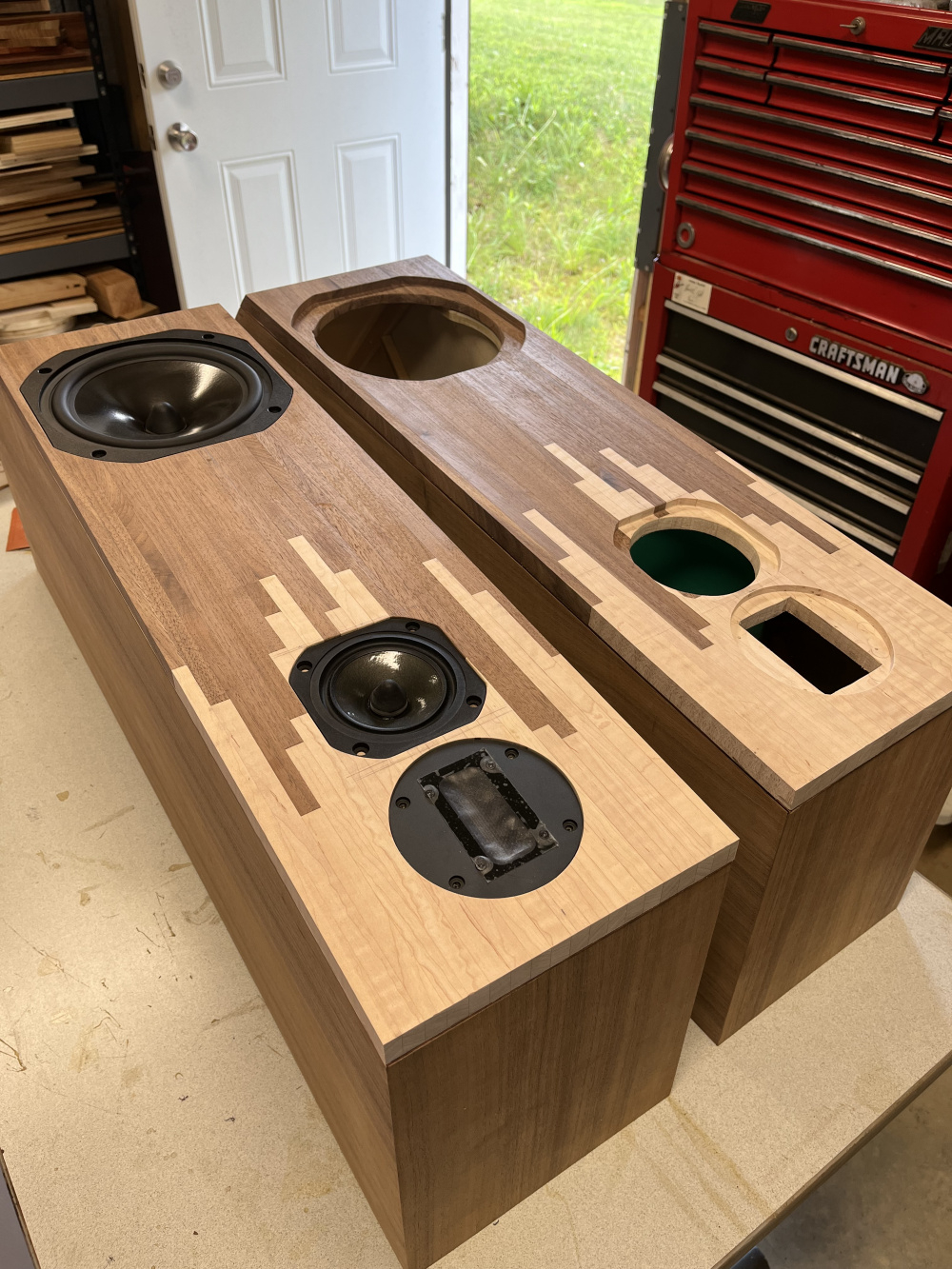
That is a very good looking build !
Looking forward to your crossover frequencies and orders (with the woofer being near floor orientated).
Very nice Eric. I like the unique look.
Looks really cool! Are the frequency response graphs perfect mirror images of each other?
Yes they are. I thought about both being randomly different, but opted for symmetrical mirror image.
Started getting the solid stock walnut milled flat. Got a few hours in before the rain came.... again.🤦🏻♂️ Anyway, got the boards roughed in, just need to pick two and make them the same thickness. This spoilboard surfacing bit rocks!!
https://ebay.us/m/Y3E86U
Made a hell of a mess, sending walnut dust everywhere, including stuck all over me because of the wonderful weather we have. I swear the humidity had to have been 95%!!
Here's a few shots of the routing jig I set up to flatten the boards.
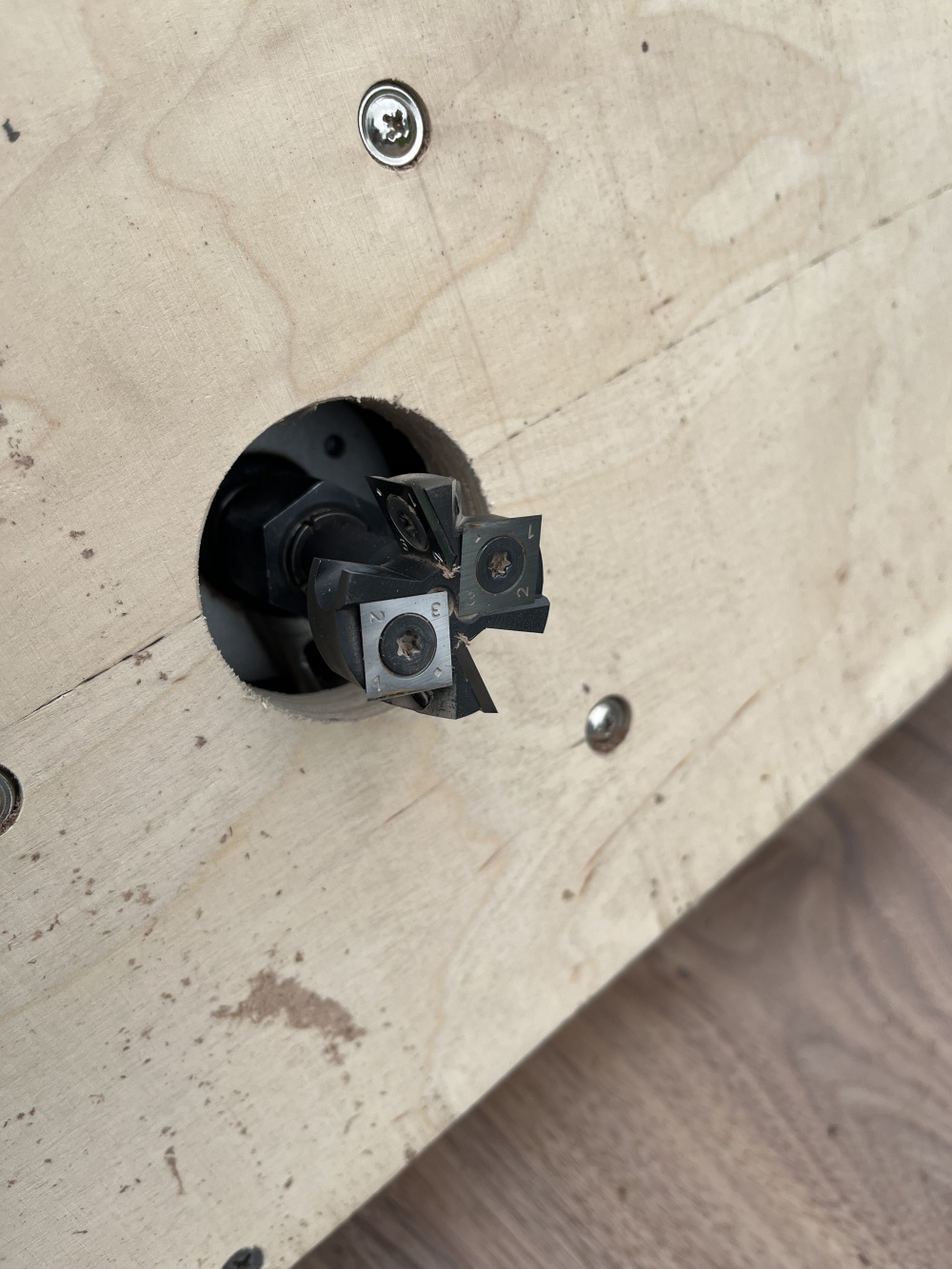

That cutter head looks the business, mate!
Doesn't walnut dust give you a terrible headache?
Does me . . .
Never seen a router bit like that! What the f?
Built several router flattening jigs. Always much fun when they work!
That bit looks serious! I'll bet it can chew right across any knots without breaking a sweat.
Those are CNC surfacing / flattening bits. They have replaceable blade inserts (the screw removed them) and you can turn the square blade 90 degrees and get 4 times the usage out of one cutter! Nice jig! Something about making your own jigs and using them is really rewarding. I’ve been wanting to do a miter spline jig for a long time.
No, can't say that it does. I use one of these when routing...
https://www.uline.com/Product/Detail/S-23924BLU/Cooling-Products/Cooling-Multi-Band-Blue?pricode=WC0785&gadtype=pla&id=S-23924BLU&gad_source=1&gad_campaignid=12158643340&gbraid=0AAAAAD_uetMstTycH7Sf5Ot_EwySfarVs
As @D1PP1N stated, you get 4 cutting surfaces to use as the bit wears. First time I tried one and have to say I'm a big fan of it. It leaves a decent finish that's easily sanded smooth.
The cutter inserts are replaceable and are fairly inexpensive too. I use a similar insert on my boring bar for the lathe at work..
Got the bases cut out. They have ~5 degree bevel on all four sides, basically mimicking the baffle angle.
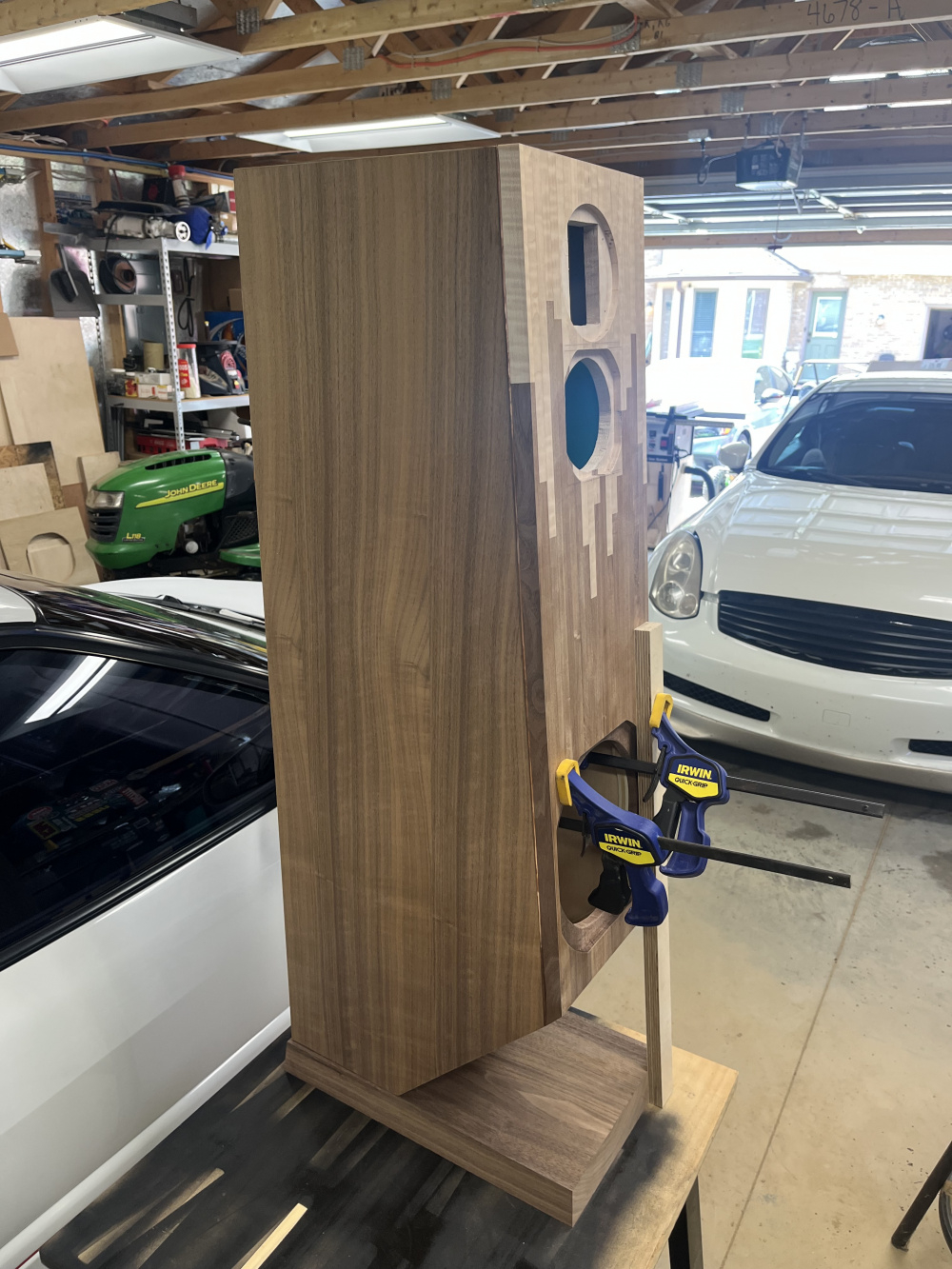
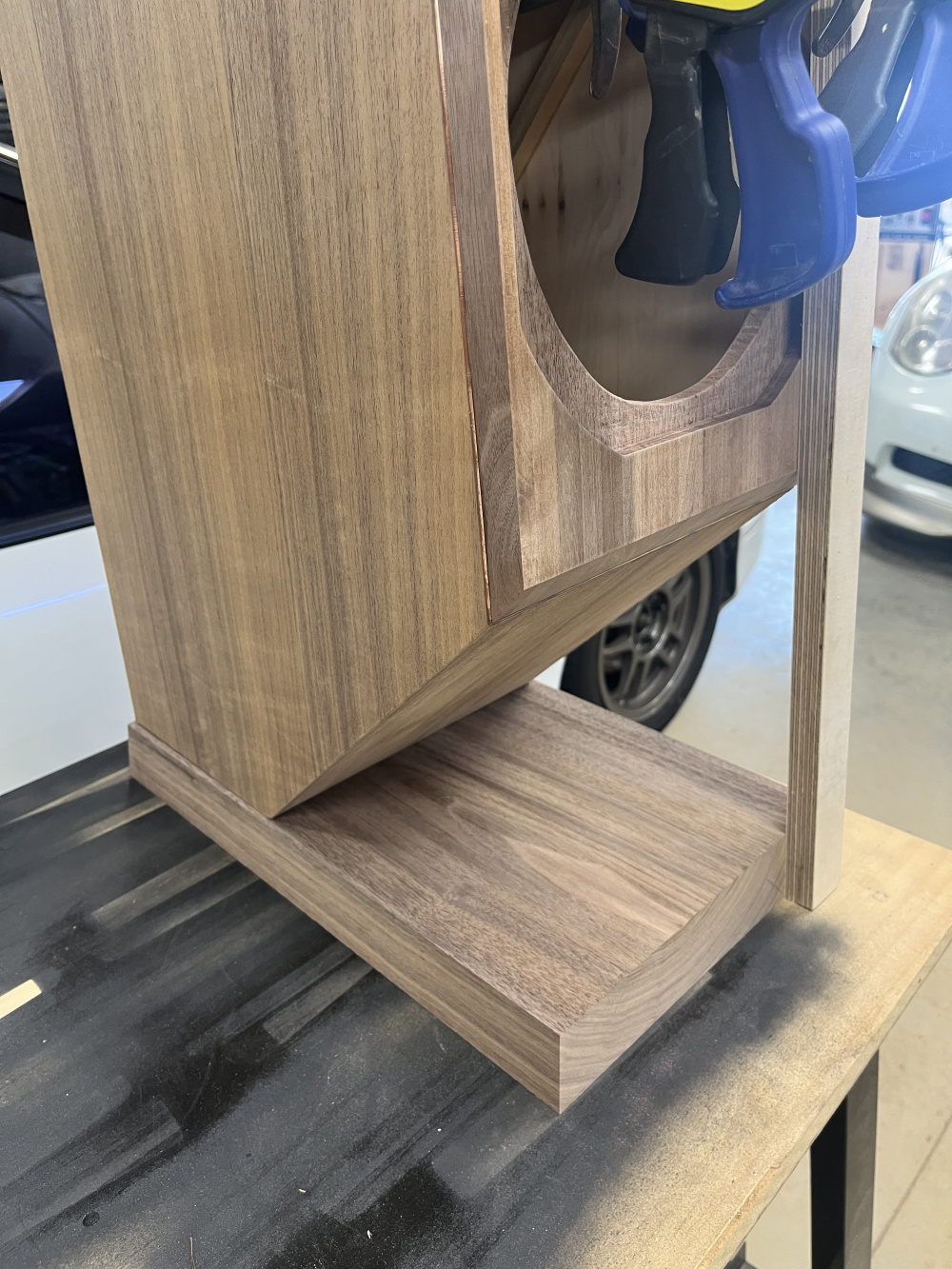
I wanted to put the crossover in the base, but depends on the inductors that end up being used. We'll see.
Looking good. I like the idea of putting the crossover in the base.